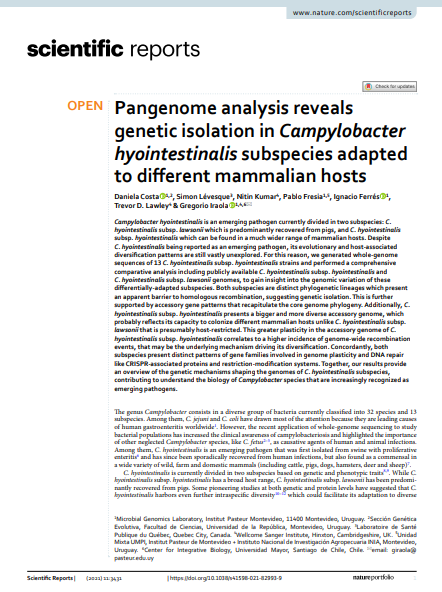Pangenome analysis reveals genetic isolation in Campylobacter hyointestinalis subspecies adapted to different mammalian hosts

Fecha
2021-02-09Autor
Costa, Daniela
Levesque, Simón
Kumar, Nitin
Fresia, Pablo
Ferres, Ignacio
Lawley, Trevor D.
Iraola, Gregorio [Univ Mayor, Ctr Integrat Biol, Chile]
Ubicación geográfica
Notas
HERRAMIENTAS
Acceda a títulos restringidos
¿Cómo descargar?Resumen
Campylobacter hyointestinalis is an emerging pathogen currently divided in two subspecies: C. hyointestinalis subsp. lawsonii which is predominantly recovered from pigs, and C. hyointestinalis subsp. hyointestinalis which can be found in a much wider range of mammalian hosts. Despite C. hyointestinalis being reported as an emerging pathogen, its evolutionary and host-associated diversification patterns are still vastly unexplored. For this reason, we generated whole-genome sequences of 13 C. hyointestinalis subsp. hyointestinalis strains and performed a comprehensive comparative analysis including publicly available C. hyointestinalis subsp. hyointestinalis and C. hyointestinalis subsp. lawsonii genomes, to gain insight into the genomic variation of these differentially-adapted subspecies. Both subspecies are distinct phylogenetic lineages which present an apparent barrier to homologous recombination, suggesting genetic isolation. This is further supported by accessory gene patterns that recapitulate the core genome phylogeny. Additionally, C. hyointestinalis subsp. hyointestinalis presents a bigger and more diverse accessory genome, which probably reflects its capacity to colonize different mammalian hosts unlike C. hyointestinalis subsp. lawsonii that is presumably host-restricted. This greater plasticity in the accessory genome of C. hyointestinalis subsp. hyointestinalis correlates to a higher incidence of genome-wide recombination events, that may be the underlying mechanism driving its diversification. Concordantly, both subspecies present distinct patterns of gene families involved in genome plasticity and DNA repair like CRISPR-associated proteins and restriction-modification systems. Together, our results provide an overview of the genetic mechanisms shaping the genomes of C. hyointestinalis subspecies, contributing to understand the biology of Campylobacter species that are increasingly recognized as emerging pathogens.
URI
https://repositorio.umayor.cl/xmlui/handle/sibum/9152https://www.ncbi.nlm.nih.gov/pmc/articles/PMC7873201/pdf/41598_2021_Article_82993.pdf
https://doi.org/10.1038%2Fs41598-021-82993-9
https://www.biorxiv.org/content/biorxiv/early/2019/04/05/600403.full.pdf
https://www-nature-com.bibliotecadigital.umayor.cl:2443/articles/s41598-021-82993-9.pdf
Coleccion/es a la/s que pertenece:
Si usted es autor(a) de este documento y NO desea que su publicación tenga acceso público en este repositorio, por favor complete el formulario aquí.